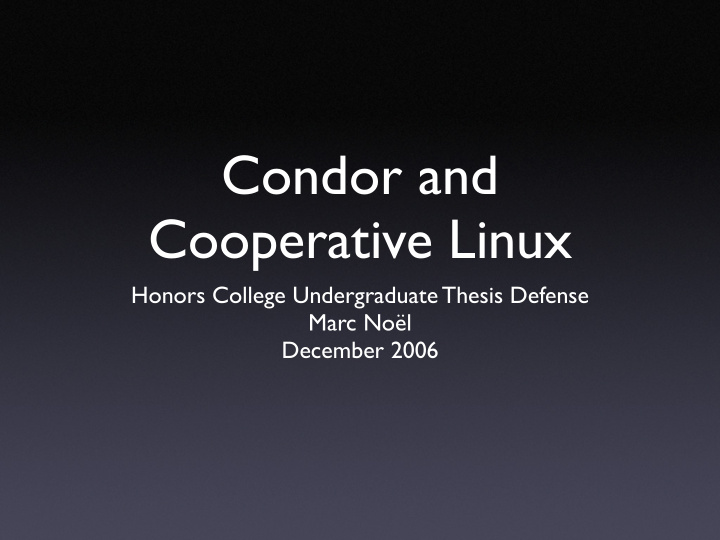



Condor and Cooperative Linux Honors College Undergraduate Thesis Defense Marc Noël December 2006
Motives
Total LSU HPC Capacity SuperMike 6.267 TFLOPS SuperHelix 1.024 TFLOPS Pélican 0.851 TFLOPS Nemeaux 0.256 TFLOPS Santaka 0.192 TFLOPS Total 8.590 TFLOPS
LSU ITS Desktops Labs: 369 Classrooms: 176 ITS + testing total: 1400
Augmented LSU HPC Labs + Classrooms 1.09 Tflops 13% ITS 2 Tflops 23% ITS + Testing 2.8 Tflops 33% Estimations 4 Tflops 47%
Methods
Condor • Scheduler: sends jobs to idle machines • Embarrassingly parallel: no communication between nodes, no MPI • Relevant features: checkpointing, idle time measurement, centralized authentication, parameter sweeping
Typical Commands
Binary Compatibility • Condor works best with Windows and Linux • Linux programs can’t run in Windows and vice versa: different executable formats • Re-compile programs for each architecture? • Libraries: source? exist on target platform? • Time? Feasibility?
Dual Boot? • Run Windows and Linux one at a time • Best option for compatibility and speed • Summer 2004 - Summer 2005 • Failure • Lack Linux administrators • Too much change on Windows side
VMWare vs. coLinux General-purpose Kernel as coroutine Multi-core Single processor 77% native speed 79.3% native speed 87 MB overhead 100 MB overhead Commercial GPL
Implementation Issues • coLinux immaturity: networking support • Breadth of experience: Windows services, C programming, Linux administration + scripting • Politics • Passwords and administrative access • Disrupted policies • User experience degradation
Results: Demo
Upcoming
• On-boot service for idle times and startup • Self-extracting installer or .msi • Users: UCoMS, Cactus TFM, researchers • Flocking with LIGO • Simultaneous Condor on Windows and Linux • PBS and Condor unification
mnoel@cct.lsu.edu
Recommend
More recommend